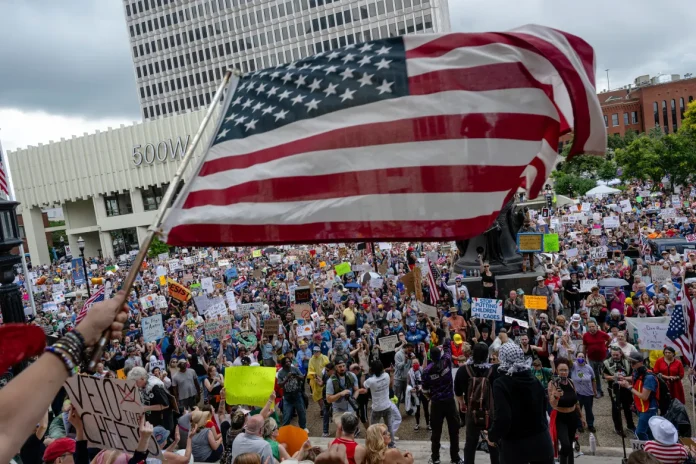On 14 June, coordinated protests took place across dozens of US cities in opposition to President Donald Trump and his administration. These demonstrations were held under the slogan No Kings and coincided with Trump’s 79th birthday and a major military parade in Washington, D.C., marking the 250th anniversary of the US Armed Forces.
Organisers of the No Kings campaign stated that the movement stands against what they describe as increasing authoritarianism, policies favouring the wealthy elite, and the growing militarisation of American democracy. The protests drew substantial public participation and media attention across numerous states.
Cities and numbers
In Los Angeles, one of the largest demonstrations saw an estimated 30,000 people gather near City Hall. The protest extended past curfew, prompting the police to use rubber bullets. The city’s mayor confirmed the turnout, noting that it was the largest protest in the city since the previous week, when unrest broke out following immigration raids and federal funding disputes. The National Guard was deployed without a formal request from California’s state government, a move that drew criticism from local Democratic leaders.
Philadelphia witnessed a significant turnout of around 80,000 participants. Protesters gathered at LOVE Park and marched to the city’s Museum of Art. Many carried US flags or homemade placards, some comparing the current political environment to authoritarian regimes. Common chants included “This is what democracy looks like” and “Trump, step down.” The demonstrations in the city remained largely peaceful.
In New York City, approximately 500 protesters assembled in central Manhattan on Fifth Avenue, disrupting traffic in several areas. Demonstrators carried signs with slogans such as “No Kings, No Dictators,” and many criticised the military parade held the same evening in the capital.
Washington D.C. and its suburbs also saw notable gatherings. Hundreds of protesters demonstrated near the headquarters of Fox 5 television in Bethesda, Maryland, holding placards and chanting slogans like “Trump summons demons” and “Impeach now.” Others gathered in Lafayette Square near the White House, calling for Trump’s resignation. Protesters were separated from the presidential residence by security fences erected in advance.
Other cities reporting large-scale activity included Houston, San Antonio, and Salt Lake City. In San Antonio, thousands marched through the city centre, while in Salt Lake City, a shooting incident during the protests left one person critically injured. Police detained a suspect in connection with the incident.
In Alexandria, Virginia, a protest event included planned speeches by Democratic Congressman Don Beyer and state legislators. In Minnesota, demonstrations were cancelled following the fatal shooting of a prominent Democratic politician, prompting law enforcement to recommend avoiding political gatherings until the suspect was apprehended.
The military parade in Washington
A military parade took place in Washington D.C. on 14 June to celebrate the 250th anniversary of the US Army. It featured troops in historical uniforms spanning from the Revolutionary War through to the present day. Military helicopters, armoured vehicles, and tanks such as the Abrams were also showcased.
According to various estimates, the parade drew around 200,000 spectators and cost US taxpayers between $25 million and $45 million. Critics, including some of Trump’s political opponents, questioned the necessity and symbolism of such an event, suggesting it resembled the practices of authoritarian regimes. Military parades are not traditionally held in the US and have rarely been used as a tool of public celebration.
Public and political reactions
President Trump dismissed the protests, suggesting they were funded by political adversaries. Attorney General Pam Bondi issued a warning that looting would be met with firm measures. Special response units equipped with heavy military gear were deployed in several cities including Seattle, Chicago, Philadelphia, northern Virginia, and New York, although the exact timeline of federal operations remained unclear.
Supporters of the president defended the parade and dismissed the protests as partisan acts. Some conservative media outlets criticised the No Kings campaign as politically motivated and accused organisers of undermining public order.
Despite contrasting views, the coordinated protests made headlines across the country and sparked renewed debate around executive power, civil liberties, and the role of public protest in American democracy.
